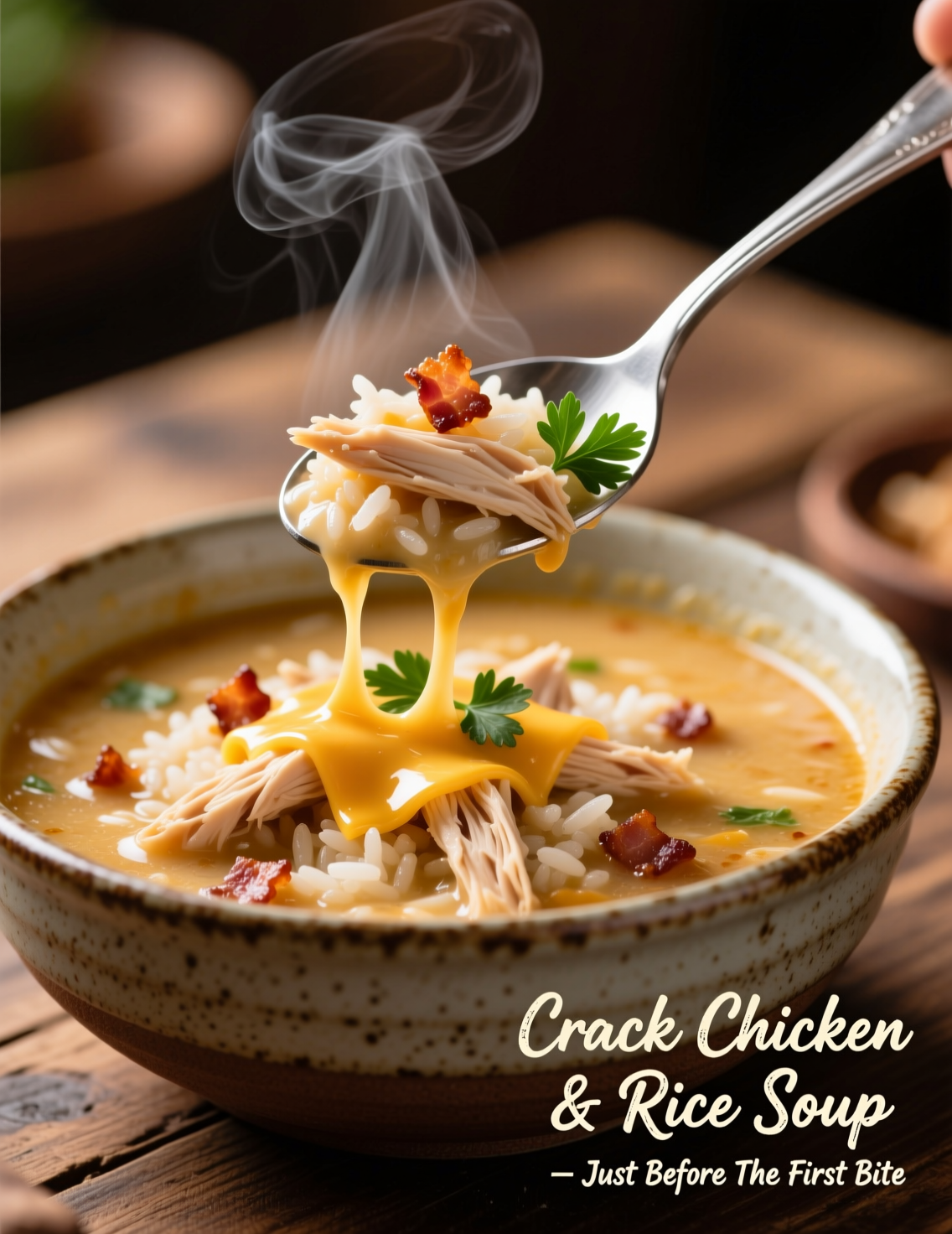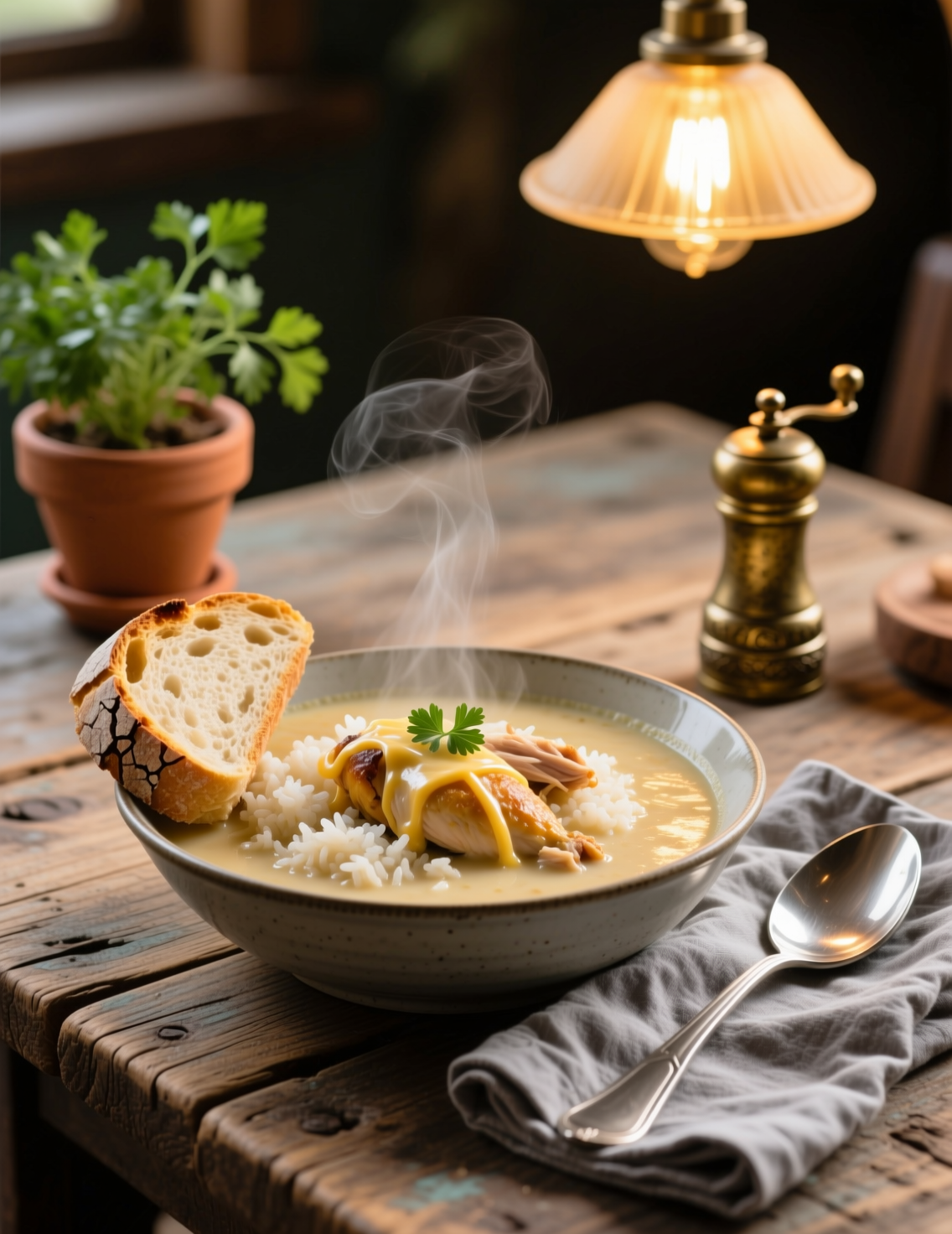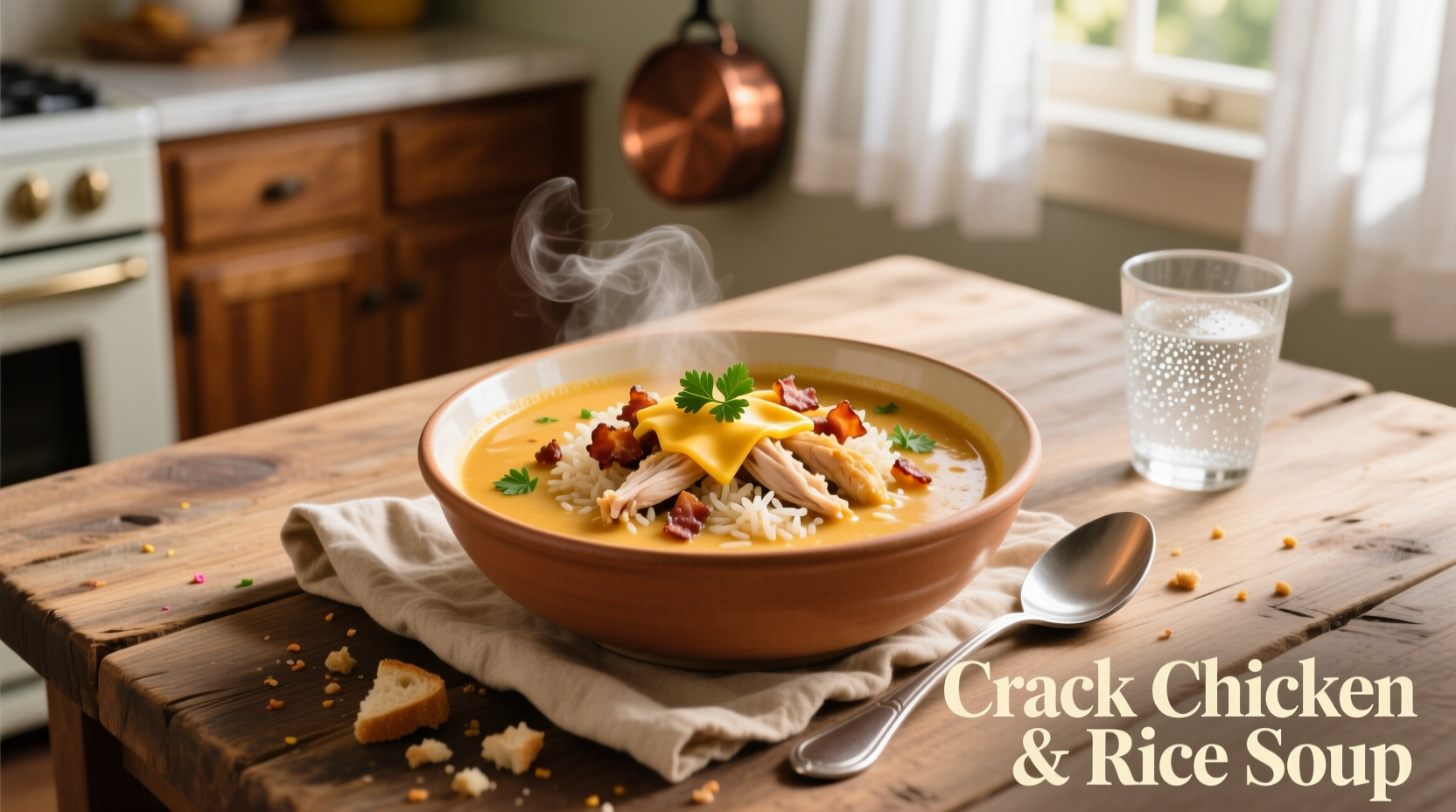There’s something wild about how Crack Chicken and Rice Soup took over kitchens across America. It’s creamy, cheesy, salty, and warm — the kind of soup that doesn’t just fill your stomach but practically hugs your soul. This isn’t your average “throw-it-all-in” soup. Nope. When done right, it’s a balanced bowl of protein, carbs, and indulgent flavor that even seasoned chefs respect for its crowd-pleasing magic.
If you’re after a deeply nourishing soup with bold flavor and reliable structure, this Crack Chicken and Rice Soup recipe is where comfort meets expertise. Let’s get our ladles ready.
The Origins and Popularity of Crack Chicken and Rice Soup
The term “crack chicken” first appeared online around the early 2010s, referring to the combination of chicken, cream cheese, cheddar, and ranch seasoning. It’s called crack because—well—it’s absurdly addictive. People couldn’t stop making it. Soon enough, someone clever added rice and broth, and boom, this soup was born.
In culinary terms, it’s a modern comfort dish that borrows from traditional American casseroles. Think of it as a creamy cousin to chicken and rice casserole but silkier and spoonable. What makes it fascinating to professional cooks is its adaptability—how small tweaks can drastically change its profile.
Why This Recipe Works
Balancing fat and starch in soup-making is a subtle science. This recipe works because the dairy fats from cream cheese and cheddar emulsify into the broth, giving a velvety consistency without splitting. The rice acts as both texture and a mild thickener, absorbing flavor as it cooks.
Unlike soups that rely heavily on roux or cornstarch, this one uses natural thickening through rice starch. It’s a technique reminiscent of classical French cooking—where grains, not gums, give the soup its body.

Ingredients You’ll Need (For 6 Servings)
- 1 ½ pounds boneless, skinless chicken breasts (or thighs for more richness)
- 1 cup long-grain white rice (uncooked)
- 6 cups chicken broth, preferably low-sodium
- 8 oz cream cheese, softened
- 1 cup shredded sharp cheddar cheese
- 1 cup heavy cream
- 1 packet ranch seasoning mix (or 2 tbsp homemade blend)
- 1 tbsp olive oil or butter
- ½ cup diced celery
- ½ cup diced carrots
- 1 small onion, chopped fine
- 3 cloves garlic, minced
- ½ tsp smoked paprika (optional but deepens the flavor)
- Salt and black pepper to taste
- Chopped green onions and cooked bacon bits for garnish
The Step-by-Step Process (Expert Notes Included)
1. Sear the Chicken Properly
Heat olive oil in a large Dutch oven over medium-high heat. Add chicken and sear each side until lightly golden, about 2–3 minutes per side. You’re not cooking it through—just building that Maillard layer. That crust gives depth later in the broth.
Remove the chicken and set it aside. You’ll notice little browned bits at the bottom of the pot—those are fond, and they’re flavor gold.
2. Sweat the Aromatics
Add onions, carrots, and celery to the same pot. Cook for 5 minutes until soft and slightly translucent. Add garlic for the last 30 seconds. You want the garlic fragrant, not bitter. This mix—called mirepoix in classical kitchens—forms the soul of most soups.
3. Deglaze Like a Pro
Pour in half a cup of broth, scraping up the fond. This dissolves the caramelized proteins back into the liquid. It’s the difference between flat-tasting soup and something that lingers on the tongue.
4. Simmer and Infuse
Add the chicken back to the pot, then pour in the remaining broth. Stir in the ranch seasoning and paprika. Bring it to a boil, then reduce to a gentle simmer. Cover partially and let it cook for about 15 minutes.
5. Add the Rice
Once the chicken is nearly cooked, stir in the rice. Simmer uncovered for another 15–18 minutes until the rice is tender and the chicken can be easily shredded. Keep stirring occasionally to prevent rice from sticking to the bottom.
6. Create the Cream Base
Remove the chicken, shred it with two forks, then set aside. Lower the heat to medium-low. Add cream cheese in cubes, stirring until melted. Next, stir in the heavy cream and cheddar cheese gradually. Don’t rush this—high heat will make dairy curdle.
7. Reunite Everything
Return shredded chicken to the pot. Stir gently. The soup should now look thick, creamy, and luxurious. Taste and season with salt and pepper. If it feels too thick, a bit of warm broth can loosen it.
8. Garnish Like You Mean It
Ladle into bowls, top with crispy bacon bits, and sprinkle green onions. That salty crunch balances the rich creaminess beautifully.
The Science Behind the Flavor
Chefs know good cooking isn’t random—it’s controlled chemistry. Here, we’re working with fat emulsification, starch gelatinization, and flavor layering.
- Emulsification: When you melt cream cheese slowly, its proteins stabilize fat droplets, creating a uniform texture.
- Rice Starch: As the rice cooks, it releases amylose and amylopectin. These polysaccharides naturally thicken the broth.
- Salt Fat Acid Heat: The ranch mix adds salt and acid (buttermilk powder), while cheese and cream add fat. Balancing these elements makes the soup addictive without being heavy.

Common Mistakes (and How to Avoid Them)
Using Pre-Shredded Cheese – Don’t. It’s coated in anti-caking agents that make your soup grainy. Grate fresh cheese; it melts cleaner.
Cooking Rice Too Early – Rice soaks up liquid fast. If you add it too early, you’ll end up with mush. Timing is key.
High Heat with Dairy – The number one reason cream soups split. Always drop the heat before adding dairy, and stir patiently.
Skipping Seasoning Layers – Add salt gradually, not all at once. The flavor changes as the soup thickens.
How to Store and Reheat
This soup stores beautifully but needs gentle handling. Refrigerate in airtight containers up to 3 days. For longer storage, freeze before adding the dairy base, then reheat and stir in the cream and cheese fresh.
When reheating, use low heat and a splash of broth or milk to restore creaminess. Microwaving on high often breaks the emulsion, so stovetop is best.
Professional Variations
1. Smoked Chicken and Gouda Version
Swap cheddar for smoked gouda and use pre-smoked chicken breast. Add a dash of white pepper for warmth. This version has a bistro-level smokiness that pairs well with sourdough.
2. Lightened-Up Variation
Use Greek yogurt instead of cream cheese, and low-fat milk instead of heavy cream. Add extra carrots and spinach for volume. You’ll lose a bit of indulgence but keep that same creamy texture.
3. Wild Rice Upgrade
For deeper flavor and bite, replace long-grain white rice with wild rice. It takes longer to cook (about 40 minutes), but the nutty aroma and chewy texture make it unforgettable.
Nutrition Profile (Per Serving Estimate)
- Calories: ~530
- Protein: 38g
- Fat: 27g
- Carbohydrates: 30g
- Sodium: 820mg
While it’s definitely on the richer side, it’s also balanced in macronutrients. For athletes or culinary professionals, this makes a brilliant post-shift recovery meal.
Expert Insight: Why Chefs Love This Soup
Professional cooks adore this dish for one big reason—it’s forgiving. Even if your ratios aren’t perfect, the soup self-corrects as it simmers. That’s because rice and dairy naturally stabilize each other. It’s a rare combination where both science and intuition play equal roles.
In fine-dining settings, chefs might elevate it with garnishes like chive oil, crispy leeks, or even truffle salt. But the heart of the soup remains the same—cozy, creamy, craveable.
Frequently Asked Questions
What is Crack Chicken and Rice Soup?
It’s a creamy, cheesy chicken soup made with rice, cream cheese, cheddar, and ranch seasoning for rich comfort flavor.
How many servings does this recipe make?
This Crack Chicken and Rice Soup recipe makes 6 generous servings.
Can I use cooked chicken instead of raw?
Yes, add cooked or rotisserie chicken during the final simmer to warm through.
What type of rice works best?
Long-grain white rice is ideal for texture and consistency.
Can I make this soup ahead of time?
Yes, but add dairy just before serving to keep the soup smooth and creamy.
Is this recipe freezer-friendly?
Freeze before adding cream and cheese; add them fresh when reheating.
Can I make it dairy-free?
Use dairy-free cream cheese, plant-based milk, and vegan cheddar alternatives.
How do I thicken the soup more?
Simmer uncovered a few extra minutes or mash some rice with a spoon.
What’s the best garnish for serving?
Crispy bacon bits, green onions, or shredded cheddar add flavor and crunch.
Can I cook it in an Instant Pot?
Yes, pressure cook everything but dairy for 10 minutes, then stir in the cheese and cream.
A Short Story from a Chef’s Notebook
A few winters ago, during a catering event in upstate New York, I served a refined version of this soup as a “starter shot.” It was ladled into espresso cups, topped with crisped pancetta, and finished with a drizzle of chive oil. Guests sipped it like it was something holy. That’s when I realized — comfort food, when executed precisely, can be just as elegant as haute cuisine.
Emerging Trends Around Creamy Chicken Soups
Modern kitchens are taking the classic crack chicken idea and spinning it into lighter, fusion-driven dishes. You’ll see variations using coconut milk instead of cream, or jasmine rice for a Southeast Asian twist. Some chefs even introduce fermented elements like miso paste or kimchi to balance the richness with umami acidity.
Even with these evolutions, the core principle stays the same — creamy, savory depth with balanced salt and texture. It’s proof that simplicity still wins hearts, even in the age of foams and reductions.
Final Thoughts
Crack Chicken and Rice Soup might wear a casual name, but it’s built on serious culinary fundamentals — balance, technique, and timing. For professionals, it’s a reminder that the most beloved dishes often spring from humble ingredients elevated through care.
So next time you stir that pot, remember: you’re not just making soup. You’re layering memories in broth, starch, and cream. And when that spoonful hits the bowl, you’ll see — this isn’t just comfort food. It’s craftsmanship.

Mariana is a passionate home cook who creates delicious, easy-to-follow recipes for busy people. From energizing breakfasts to satisfying dinners and indulgent desserts, her dishes are designed to fuel both your body and hustle.
When she’s not in the kitchen, she’s exploring new flavors and dreaming up her next recipe to share with the Foodie Hustle community.

